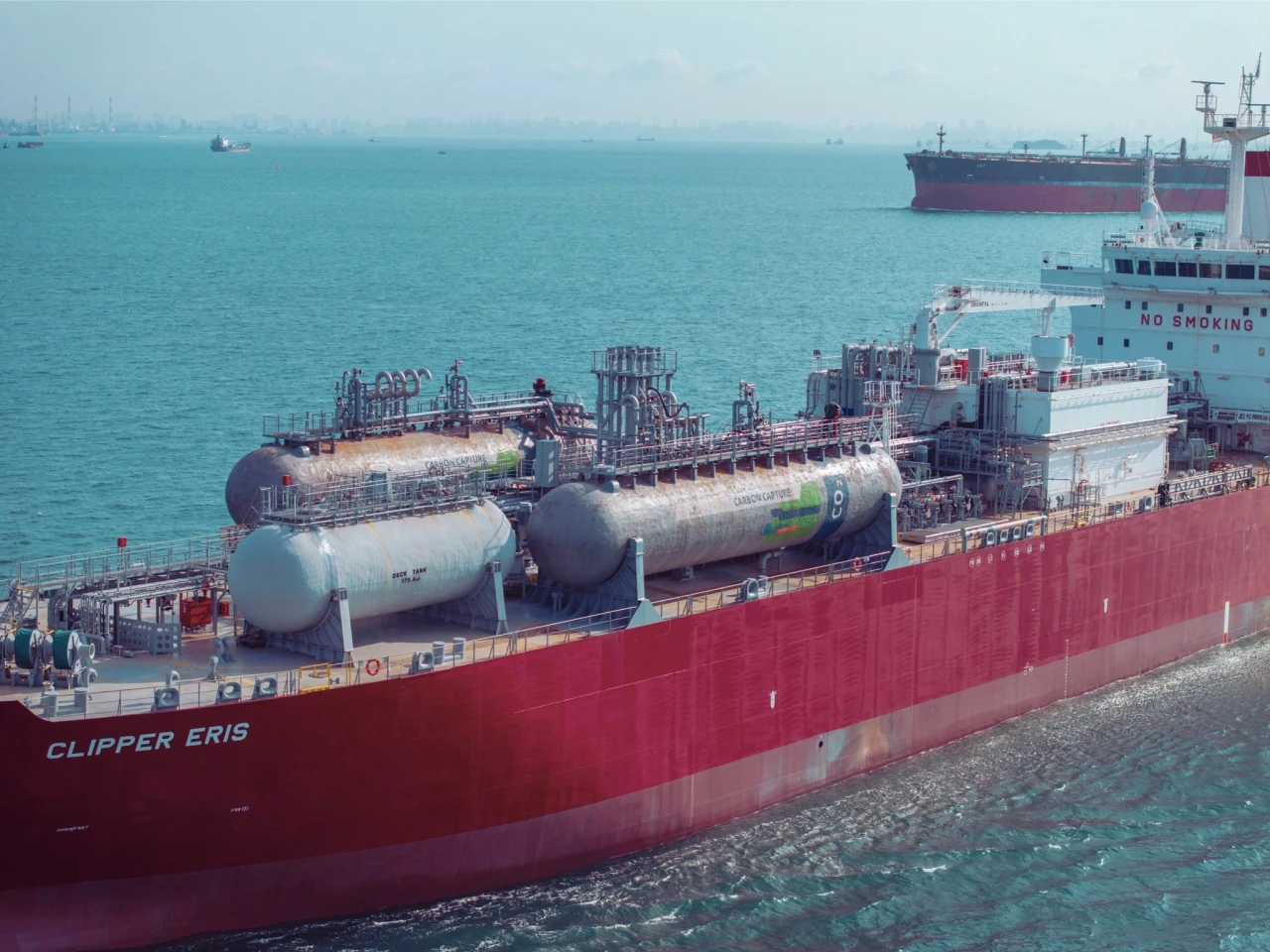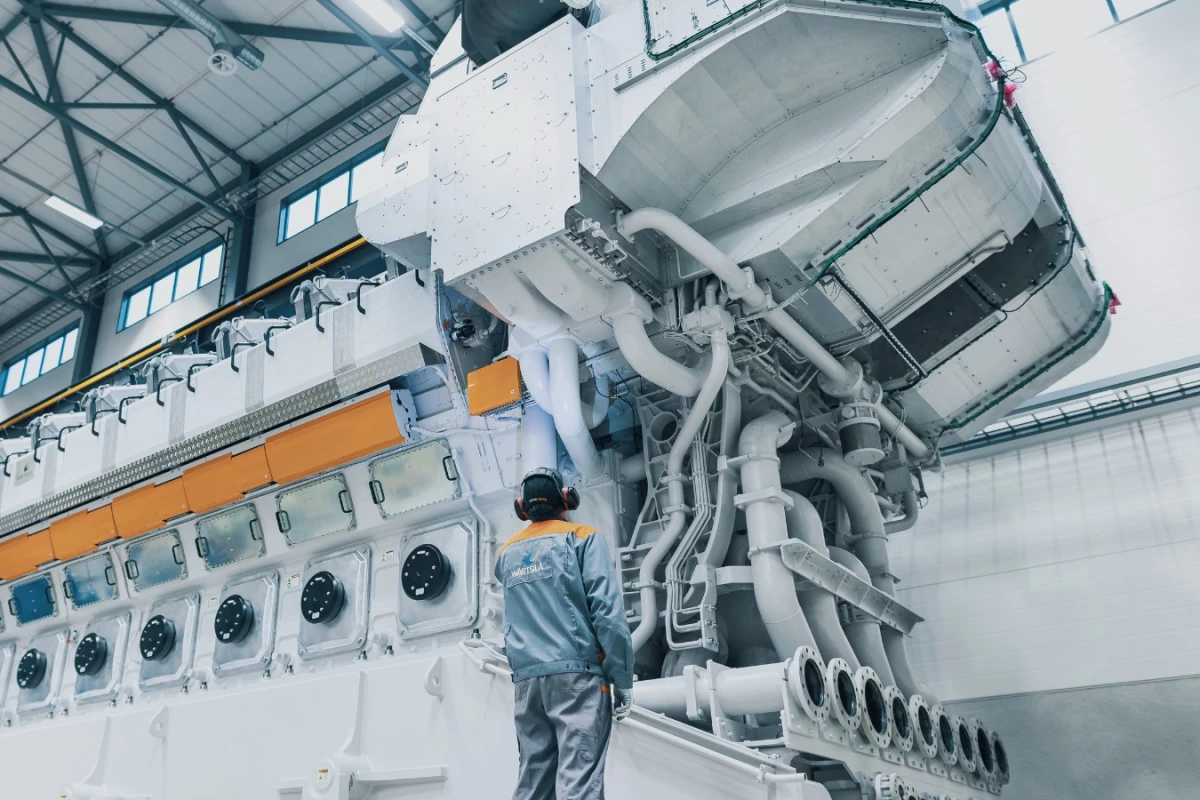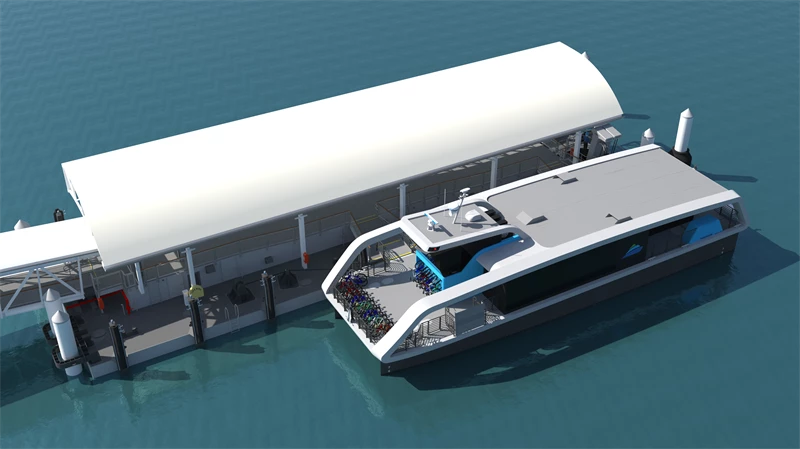Once famous for building the world's biggest and most powerful engines, Finnish company Wärtsilä is investing heavily in technology to clean up the notoriously difficult heavy marine sector. CEO Håkan Agnevall lays out a roadmap to zero carbon 2050.
"Today, we're serving two industries: marine and energy," says Agnevall. "Marine is about 60% of our business, energy is 40%. We use the same type of piston engines in both industries, that's the core of the business. Now, our strategy, if you want to sum it up in one word, it's about decarbonization."
Along with aviation, heavy marine is shaping up as one of the toughest-looking sectors in the race to zero carbon emissions by 2050. Massive cargo and passenger ships typically run on massive quantities of sludgy "bunker fuel." This sticky, tar-like goop is basically what's left over when all the higher-grade fuels have been distilled or cracked out of petroleum oil.
High-sulfur bunker oil is about the cheapest and dirtiest fuel on the market, and on a typical day, under normal operating conditions, a big cargo ship like the Emma Maersk will feed about 312 tonnes (84,200 gallons, 318,700 liters) of it into its mammoth 109,000-horsepower Wärtsilä RT-series engine, producing more than 1,000 tonnes of greenhouse emissions. Per day. Which is not to say that shipping is bad – it's the undisputed engine of global commerce and an extremely efficient way to move bulk stuff from A to B. But the scale of the marine emissions problem is epic.

So what's Wärtsilä's solution? "We have a saying: green is not black or white," says Agnevall. "There are no single simple solutions. There will not be a silver bullet. There will be different types of fuels, there will be abatement solutions, there will be hybrid systems, et cetera, et cetera. That's a journey, and it has started, and it's accelerating."
Here are some of the key elements that'll combine to form a genuine pathway to carbon zero, according to Agnevall.
1) MEPC 83: The global marine industry's plan to launch its own carbon tax
Shipping emissions are a global problem, and the world can't wait for national governments to all get on board. The International Maritime Organisation (IMO) has just approved a plan, set to be formally adopted in October, that'll effectively put a mandatory "well-to-wake" carbon and emissions tax on the entire sector.
"This is a proposal," says Agnevall. "The final decision is in October. And if the decision is taken, it's a milestone for the marine industry. It'll be one of the first industries in the world to actually introduce a global carbon fee as a carrot and a stick to incentivize the decarbonization journey."
The specific piece of legislation being changed – the International Convention for the Prevention of Pollution from Ships (MARPOL) – already has 108 parties signed up, comprising some "97% of the world's merchant shipping fleet by tonnage." If ratified, it'll set gradually tightening emissions standards on all large ships, and place "remedial unit" penalties of US$100 and $380 per tonne of CO2 emissions over the allowed limits for different "tiers" of infractions, starting as soon as 2028 and tightening up substantially from there.
Zero or near-zero carbon operators will be able to tap into these carbon penalty dollars as rewards, so the system is designed to incentivize the expensive R&D required by early movers.

2) Digital schedule optimization
It sounds absolutely bananas, but if the shipping and ports industries could just sync up their watches, the marine cargo sector could cut its fuel burn and greenhouse emissions by between 8-30% overnight, without laying a wrench on the vessels themselves at all. Ships would mostly simply go a bit slower, without any disruption to their schedules.
How? Surely rocking up later would mean goods took longer to get delivered?
"Marine doesn't work like that," says Agnevall. "There's a schedule, but it's approximate. You're going to arrive at a certain time, and you're supposed to get access to the quay so you can unload. But what happens in reality is the captain sets out and he makes good efforts to mitigate winds and whatever, and he arrives at a certain porrt at the right date. But the port might be full, because the planning system is not as advanced as in the air industry. So the port will say 'well, fantastic, you're here, but you'll have to sit and wait for a week.'"
All that fuel burned to get there on time, only to be forced to sit around in some harbor with your 1.5-million-cubic-inch (25.5-million-cc) engine idling, waiting for the docks to clear – it adds up to a gargantuan amount of waste in the system.
A solution is brewing, thanks to the Blue Visby Consortium, which is preparing for the commercial rollout of a complex global scheduling and operations system that's delivered remarkable results in early testing – as well as a system that'll share the benefits (like fuel or emissions tax savings) as well as the added costs (like additional pay for the crew, who'll be on the water longer) in a way that lets all parties benefit.

3) Onboard carbon capture
Plenty can be done with current ships simply by cleaning up their exhausts at the source, using carbon capture and storage bolt-ons.
"There's about 100,000 big vessels in the world, give or take," says Agnevall, "and you'll need to retrofit quite a few of them going forward. I would say we're on the forefront of carbon capture – we do the device that extracts the carbon, it's an extension of our scrubber business. So we can now capture 70% of the carbon, with a reasonable energy penalty because there's always an energy penalty."
The cost, he tells us, is somewhere around €50-€70 (US$58-$80) per metric ton of CO2 – but as this gas is captured and compressed into tanks on deck, it could later be sold for industrial purposes.
"It's a really efficient process," he says, "and that's fine, but now the whole ecosystem needs to evolve around how we're to offload it, and what it'll be used for. There are a lot of people in the world trying different avenues, but the ecosystem is not in place. However, we see this as one of the major retrofit solutions going forward."
4) Better fossil fuels, and multi-fuel engines
Big marine vessels are designed and financed around 25- to 30-year operational lifetimes, so there are ships being built in the next decade that'll be expected to run well into the zero-carbon era. But zero-carbon fuels simply aren't ready at scale, so the key for companies like Wärtsilä in the short term is to build multi-fuel engines that run on the best available fossil fuels of today, while being flexible enough to move to lower-carbon and zero-carbon options as they become practical.
"One big step is to go to gas," says Agnevall. "Gas is better from an emissions perspective than heavy fuel oil. We're continuing to invest in fossil technology, bringing down methane slip, et cetera ... Basically improving efficiency and thereby reducing emissions."
Natural gas is already available at scale, with a high enough energy density to replace bunker fuel on long-haul operations. Remarkably, it's also occasionally cost-competitive – according to the Chamber of Shipping of British Columbia, LNG prices in Rotterdam pulled roughly equal with high-sulfur bunker fuel in 2023, for the same amount of energy at around 20% fewer carbon emissions and vastly less particulate, sulfur and NOx emissions.
The price can fluctuate pretty wildly though, and in recent times, LNG has cost about twice as much as IFO380 bunker fuel on average.
5) Carbon-neutral fuels and methanol
Biofuels and some synthetics fall into this category, but there's also a potentially carbon-neutral fuel that's been running monster trucks and high-powered dragsters for donkeys' years.
Methanol is showing exceptional promise as an accessible, early-stage cleaner fuel for shipping. It carries a decent amount of energy, although less than half of what diesel delivers by weight or volume – but importantly, when produced renewably as a carbon dioxide recycling initiative, it can cut CO2 emissions by 95%, cut NOx by up to 80%, and can totally eliminate sulfur oxides and particulates.
It can be produced renewably; you can gasify municipal garbage and distill methanol out – which is already being done at commercial scale – or you can make some green hydrogen and combine it with captured CO2 in a reactor. But most of it's currently made using natural gas or coal. Well-to-wake, this ends up being worse than diesel.
But it does mean you can run your ship on it fairly economically in the short term, as greener methanol options become more available. I found it pretty fascinating digging into methanol as a shipping decarbonization option – you might too!
"It's not as easy as taking an existing engine and pouring methanol in the tank," says Agnevall, "But you don't replace the whole engine. It's the fuel injection, and there's quite a lot of tuning and development. So it does require new engine technology, but we have developed it and there are others that have developed it as well ... There's been quite a lot of methanol engines sold by now in the container space. So that is moving along."

6) Zero carbon marine fuel: Ammonia
Totally green fuel advances are the first place my mind goes when I think about the scale of the problem – but Agnevall very deliberately leaves this stuff til last. A gigantic cargo ship might be a great metaphor for the heavy marine industry; you can't turn it around on a dime.
The transition to green shipping will take decades. Every step needs to be practical and profitable, not just for the shipping companies, but for the entire land-based clean fuel production and distribution ecosystems that'll need to come online at exactly the right time. So even if zero carbon is the ultimate goal, it's the one that'll take the longest to roll out.
"There are basically two zero carbon fuels," says Agnevall. "There's ammonia, and there's hydrogen. There are no carbon atoms anywhere in those fuels. And our view is that if you want to go zero carbon, ammonia will be the way forward, because of its energy density."
I went down the ammonia rabbit hole back in 2021, it's a fascinating and very promising green fuel option. It stores hydrogen at 1/30th the cost of actually storing the hydrogen itself. You can burn it cleanly in a piston engine, or extract electricity through a fuel cell. It's already the second-most produced chemical on the planet, mainly for use as a fertilizer, and while the vast majority is produced using the heavily polluting Haber-Bosch process, there are some extremely promising clean ammonia production techniques starting to pop up.
It's not without issues. "Ammonia is poisonous," says Agnevall. "I mean, all these things are poisonous, but ammonia is highly poisonous. Therefore, there's a whole system that we've evolved to handle the fuel and the exhaust and everything. That's one of the major steps. We just sold our first ammonia engine ... It'll go on one of those offshore service vessels, it'll be in operation next year ... So the technology is coming – but of course, it's a new fuel, and with the safety concerns, it's a big mental shift and it'll take some time."
"We're using piston engines," he continues, "to basically burn it as fuel. You're right, there are also fuel cells, but they're still at an earlier stage. What energy efficiency will they reach? What capabilities are ramping up, ramping down? What will be the overall cost? There's still a lot of question marks around that technology. So we're focusing on the combustion engines, and they're prepared for it. We're delivering right now, with good energy efficiency – because energy efficiency is key. We're also developing our engines for hydrogen, but it's more for the land-based energy business in our case."
The challenge for all green fuels, he says, is that "they're not available today in the right quantities. Energy and marine need a lot of fuel. And they're still costly – two to four times [the price of bunker fuel]. This is why the carbon fees are needed, to create a level playing field."

6.5) Hybridization
"You know, we sketched out the major avenues," says Agnevall, "but you know, there's actually one additional one, and that's hybrid systems, combining batteries and engines."
A little electrification can go a long way, particularly when it comes to peak shaving – battery power and electric torque kick in when maximum power is needed, letting you run a smaller, lighter combustion engine. "It's really about being more efficient," says Agnevall, "you can save a lot of fuel, there's maybe a 25-30% savings potential there."
So what's our chances of a zero carbon marine sector by 2050?
"The good thing is that the technologies are here," says Agnevall. "It's not like we need some futuristic technology, it's actually here. But of course, a lot of investment is needed, and we need the financial frameworks to incentivize people to go down this route."
What are the chances of a yes vote on that crucial MEPC 83 proposal then? "Well, I just came from North Shipping, which is a big industry fair where the whole world is getting together," he tells me. "Listening to the people there – people sometimes sitting in the IMO – I think there's a careful optimism about having a decision. Of course, the US stepped out, but China, Brazil, India, Europe all voted for. So there's a careful optimism, but it's not a tick in the box yet. Let's see in October."
As for Wärtsilä's role: "We are the technology leader and we want the transition to happen," says Agnevall. "We are not trying to hold it back. We want to accelerate – but we also want to be a bit realistic, because it's a lot of capital. the transition needs to be environmentally sustainable, but it also needs to be financially viable, and therefore it will take time."
Agnevall's advice for those of us watching from afar is simple. "It's complex. Don't look for the easy solution ... Be careful, I guess, with the prophets that say they have the solution ... This transition requires the different players in the ecosystem to cooperate, nobody can make this alone. We can bring our technology, but we need the shipyards, the fuels, the operators."
"This cooperative approach is changing the way we work," he continues. "If you go back five, 10 years, the biggest secret we had was when we're going to launch a new engine or a new technology. You wanted to be first to market and benefit from that first mover advantage. That logic doesn't work these days. Now we're trying to signal that we'll have ammonia, or some other new technology, because if I'm the first and the ecosystem is not there, I won't sell anyway. Cooperation is key. It's sometimes not easy, but it's really needed for the way forward."
Check out the interview on Spotify – where we'll also be uploading future interviews – or you can see it on YouTube below.
Source: Wärtsilä











